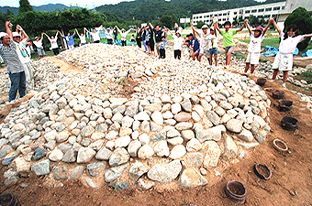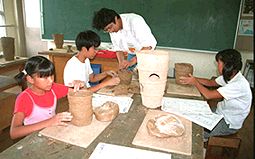|
MONTHLY NEWS October 1998 Kids Construct a Replica of Ancient Tomb |
 About 80 schoolchildren attending Daiho Elementary School and their families in Kannan, Osaka Prefecture, joined together to build a scale replica of Japan's largest burial mound, which was built in the fifth century.
About 80 schoolchildren attending Daiho Elementary School and their families in Kannan, Osaka Prefecture, joined together to build a scale replica of Japan's largest burial mound, which was built in the fifth century.
The replica measures 18 meters (59 feet) long and 12 meters (39 feet) wide, about one-thirtieth the size of the actual mound in the city of Sakai, Osaka Prefecture--believed to be for Emperor Nintoku (thought to have reigned in the early 400s). The project was organized by a history museum near the school to show schoolkids how such tombs were built. The project began in July 1998, and participants spent the entire summer working on it. Everything was made using ancient methods. Instead of using compasses and rulers, for instance, they used their feet and other parts of their bodies to measure length and make sure stones were placed accurately. They put hundreds of stones one on top of another over the keyhole-shaped mound. They also dug a moat around it. The making of haniwa, or clay figures that were buried inside, was a major part of the undertaking. Participants made clay objects in the shape of humans and animals, then baked them over an open fire using branches they collected in a nearby forest.  "I think ancient Japanese people were really smart," said Kazuki Ikushima, a student at the school. "I've become a lot more interested in burial mounds since my involvement in the project."
"I think ancient Japanese people were really smart," said Kazuki Ikushima, a student at the school. "I've become a lot more interested in burial mounds since my involvement in the project."
"I was moved when the tomb was finally completed," added Kazuyuki Takeoka. "It's our school's pride." Numerous tombs of mounded earth were built in Japan for local lords during the fourth to seventh centuries. Today, they're considered important sources of information about the social, political, and cultural life of ancient Japan.
Photos: (Top) Local families work on the mound; (above) kids make clay figures for the project. (Asahi Shogakusei Shimbun) |

|